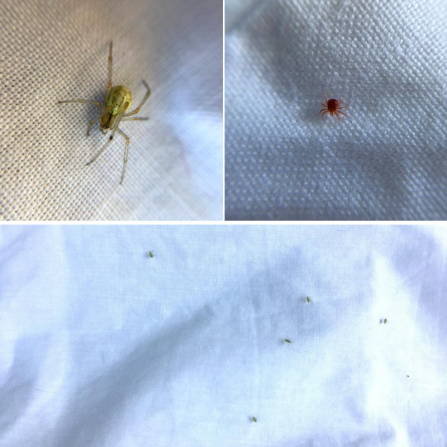Summer is the time for mini-beasts. Butterflies and beetles, caterpillars and crickets, moths and millipedes – there are so many fascinating creatures to see. Tree shaking is a really easy way to discover mini-beasts living in your garden or local green space, and is great fun for all ages.
Family activity: tree shaking for mini-beasts
You will need:
- A piece of white or pale fabric to place under the tree. An old sheet is perfect, but if you haven’t got one any pale un-patterned fabric will work. You could even use a large sheet of paper.
- Mini-beast ID guides (free downloads here)
- A magnifying glass (optional)
- Magnifying pot or jar (optional)
Step 1: choose a tree with low growing branches (you need to be able to reach them to shake) or a bush and spread out your sheet directly underneath the branch you are going to search for mini-beasts. Be careful not to choose a prickly tree like a hawthorn.
Step 2: take a firm grip on the branch above your sheet, then turn your face away from the tree and make sure everyone else is standing back. (If any bits of plant, or mini-beasts, come flying out of the tree when you shake the branch you don’t want them flying into your eyes!)
Step 3: firmly shake the branch back and forth a few times. You need to shake hard enough to make any hiding mini-beasts fall out, but be careful that you aren’t going to damage the plant. Short brisk movements are best.
Step 4: stop shaking and see what you’ve found! Some mini-beasts will crawl or fly away quickly so don’t waste any time. Kneel or crouch low over the sheet so you can spot even the tiniest animals. You may well be surprised! Look out for spiders, caterpillars, shield bugs, flies and many other creatures. If you like you can catch some in your magnifying pot or jar and take a closer look. Don’t forget to let them out again when you’re finished.
Step 5: ask yourself some questions about the mini-beasts you are looking at:
- How many legs do they have? (Insects have 6 legs but spiders have 8)
- What colours are they? Would they have been camouflaged in the tree?
- How do they move? (Crawl? Loop? Fly? Walk? Slide?)
- Are they adults or babies?
- What do you think the mini-beasts eat? Are they carnivores, herbivores or detritivores? (scroll down for some more information about these)
Use your ID guides to discover the names of the animals you have found. These are some of the things I found!

Tree shaking finds - two spiders and aphids!
Step 6: gently shake your sheet under the tree so that the mini-beasts on it fall under the tree and can climb or fly back up. Make sure you don’t walk where you’ve just shaken out the sheet!
Step 7: try shaking a different species of tree, or a tree of a different size, or in a different place. What differences do you notice in the mini-beasts you find? Some mini-beasts will live almost anywhere while others might only feed on the leaves of a certain type of plant. It might be interesting to look for mini-beasts living in the dead leaves under the tree too. Why do you think they are different?
Carnivores, herbivores and detritivores – who eats what?
Ladybird
Carnivores are animals that eat other animals. Mini-beast carnivores include spiders, ladybirds, ladybird larvae and ground beetles.
Peacock butterfly caterpillar
Herbivores are animals that eat plants. Mini-beast herbivores include aphids, caterpillars, grasshoppers and weevils.
Woodlouse
Detritivores are animals that eat detritus – bits of plant and animal that are already dead. Mini-beast detritivores include woodlice, millipedes and earthworms. Detritivores do a really important job. When they eat they tidy up all the natural “rubbish” and release the nutrients from it back into the soil so plants can absorb them to help them grow.
Here are some quick links to some of our useful spotter sheets.
Minibeast detective Ladybird detective
We'd love to see pictures of what you found!
Share them with us on Facebook
Get more family activities with our weekly wildlife email.

